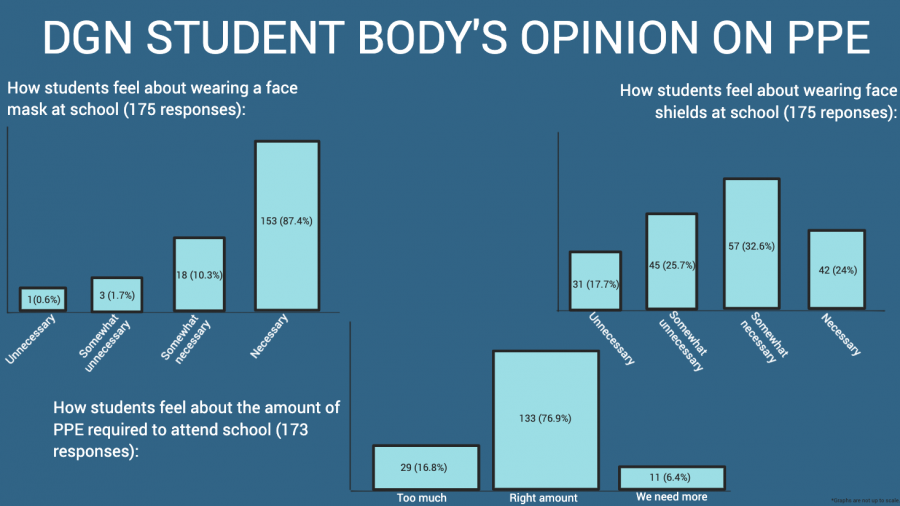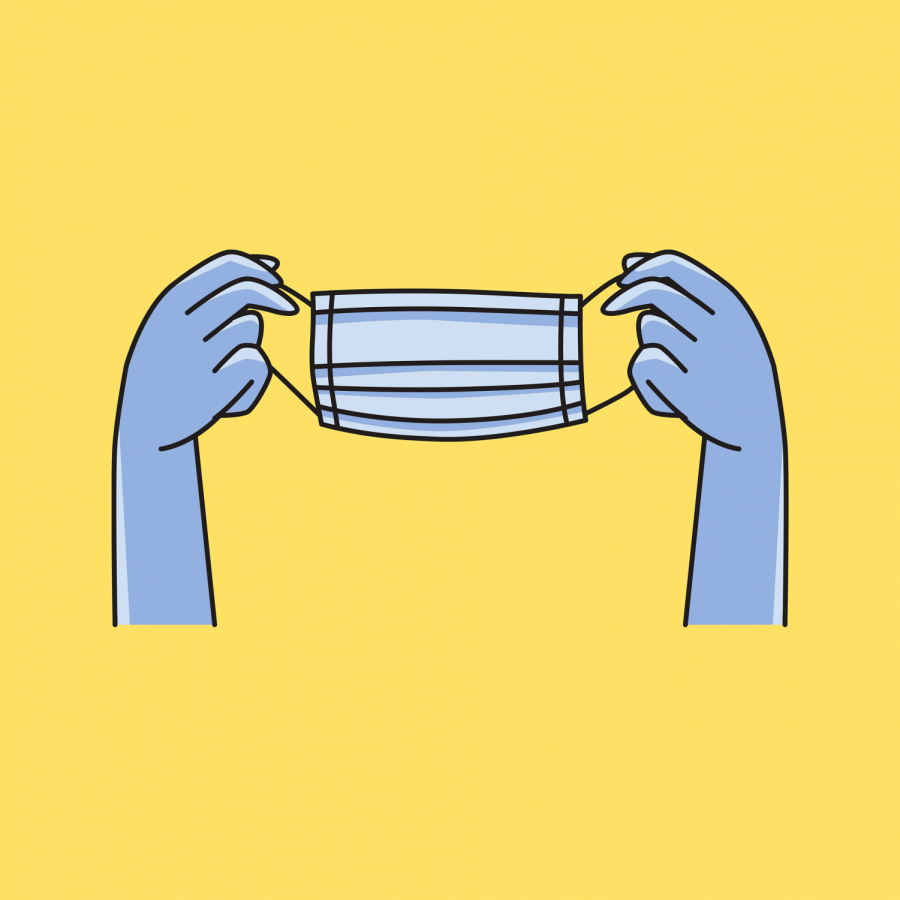Infographic created by Maeve Dietrich courtesy of Google Jamboard
Head-to-head: Are face masks and shields necessary for in-person learning?
October 31, 2020
PPE is aggravating but essential
As DGN has been given the opportunity to operate under a hybrid model, we have all added a couple of new items to our wardrobes- face masks and face shields. While it’s not New York fashion week ready or super uncomfortable to walk around with plastic and a sponge strapped to our heads, these PPE (personal protective equipment) devices are essential in keeping the school and it’s community safe.
The kid behind you that sounds like Darth Vader in his face mask, he is doing his part. An experiment performed by a high-speed camera at The New England Journal of Medicine showed a mere sentence can spew hundreds of droplets out of the mouth, but when a damp washcloth is placed in front of the mouth, nearly all of them were caught.
Face masks help prevent, however they do not provide immunity. So having another layer, such as a face shield, amplifies the prevention. The shields proved a 96 percent reduction in immediate exposure in a simulation study. A face shield protects a part of the face that a mask does and should not cover for the sake of others; the eyes. If you touch something that has the virus and rub your eyes you are exposing yourself. If you are wearing a shield you are unable to touch your eyes, just like a dog with a cone on its head- not enjoyable but safe.
If PPE was not implemented, we would be in deep trouble. One unprotected cough can spread up to 3000 droplets. You might be okay with being exposed to Covid-19 because once you’ll be mildly ill then heal you have the antibodies. But you come in contact with lots of people every day at the grocery store, the doctor’s office and so many more essential places who you could infect and severely harm. So if there is an outbreak at DGN then there is an outbreak in the community, and being responsible for that because you did not want to wear a face shield feels selfish.
The DGN community is in favor of staying safe. 76.5 percent of students who answered an Omega poll about PPE are satisfied by the current precautions the district has implemented. Over half of these students are aware of the possibility of slowing the spread and are willing to do what it takes.
If we want to stay in school, we need to be a bit over-cautious about PPE. The least that happens is that we all look like beekeepers, and the most that happens is we keep the staff and student body safe.
PPE overkill, face shields do more harm than good
For those of you attending in-person learning through the hybrid schedule, you know the struggle. The struggle of walking through the hallways, breathing through your mask, and that hot breath fogging up your newest accessory: your face shield. Not only are they the most modern fashion statement of 2020, but they are also unnecessary and bothersome.
It is hard enough to breathe through the mask after clamoring up three flights of stairs to your math class at 8 a.m. Now, with the addition of the shield, sight along with breathing becomes a hazard as well. As cold weather becomes more common with the seasonal change, shields will fog up even more as we enter the school, making it harder to see while walking through the building.
Although cases of COVID-19 are on the rise again, the use of face shields is overkill in terms of personal protection. According to the Center for Disease Control (CDC), “There is currently not enough evidence to support the effectiveness of face shields for source control.”
For Americans all over the country, the CDC’s guidelines have been commandments to live by. Their word is the law, impacting everything from how we walk into a grocery store to how many people can ride an elevator at one time. That being said, if the CDC says we don’t need them, then I truly believe we don’t need them.
Of course, they aren’t going to hurt. They could protect us from saliva particles spewing out of our classmates’ mouths or the sneeze launched from across the classroom.
With an emphasis on “could”, Kathryn Jacobsen, a professor in global health epidemiology at George Mason University said, “Most face shields do not cover the mouth and nose well enough to trap particles that wearers expel.
According to a poll given out to DGN students participating in hybrid learning, 76.5 percent of students feel more comfortable with the amount of PPE they wear now—that being a face mask and shield. Even though I may be in the minority, being a high school student myself, I can understand why people would be complacent following these rules if it means going back to school.
Face shields seem like a false sense of security. If there’s no data proving any effectiveness with their face shield it does not seem necessary to use them.
“Face shields also usually do not have filters that reduce the risk of the user breathing in viral particles,” Jacobsen said.
The plastic face shields we are required to wear most definitely do not have a filter. Consequently, any particles that it keeps out, it also allows for them to be trapped in.
Overall, face shields are an unnecessary hassle we are forced to deal with. Not only are they deemed useless by the CDC, but they are unpleasant to wear; making speech, sight, and hearing more difficult in an environment already littered with obstacles.

